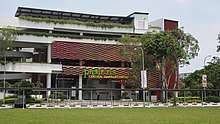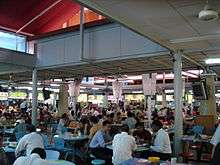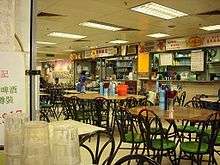Hawker centre
A hawker centre or cooked food centre is an open-air complex and food court most commonly found in Singapore. It houses many stalls that sell a variety of local and other Asian cuisines. They are typically found throughout the city-state, located near public housing estates or transport hubs (such as bus interchanges or train stations).
| Part of a series on the |
| Culture of Singapore |
|---|
 |
| History |
| Topics |
|
| Research |
| Symbols |
|


Hawker centres were set up as a more sanitary option to street-side outdoor alfresco hawker dining places. Instead of mobile food carts, permanent stalls in open air buildings are provided for the hawkers with either commonly shared or stall dedicated tables and chairs provided for patrons. This concept has totally eliminated street hawkers in Singapore. This phenomenon is also helped by hawker licensing laws. Though hawker centres can provide a one-stop destination with a good variety of high quality, sanitary food at inexpensive prices for everyone, critics claim it hinders new entrepreneurs with low capital from starting business, resulting in higher prices for established hawker centre stalls.
History
Hawker centres sprang up in urban areas following the rapid urbanisation in the 1950s and 1960s. In many cases, they were built partly to address the problem of unhygienic food preparation by unlicensed street hawkers.[1] More recently, they have become less ubiquitous due to growing affluence in the urban populations of Singapore. Such places were increasingly being replaced by food courts, which are indoor, air conditioned versions of hawker centres located in shopping malls and other commercial venues.
In the 1950s and 1960s, hawker centres were considered to be a venue for the less affluent. They had a reputation for unhygienic food, partly due to the frequent appearance of stray domestic pets and pests. Many hawker centres were poorly managed by their operators, often lacking running water and proper facilities for cleaning. Pressure from the government led to a vast improvement in hygiene standards. This includes the implementation of licensing requirements, where a sufficient standard of hygiene is required for the stall to operate, and rewarding exceptionally good hygiene.[2][3] A score of 85% or higher results in an A, and the lowest grade is a D, which ranges from 40–49% passing standards. These grades are required to be displayed on hawker stands. Upgrading or reconstruction of hawker centres was initiated in the late 1980s to early 1990s in Singapore.
In 1987, a point demerit system was introduced to account for stand's food and personal handing hygenie. Six demerit points yield a fine of S$550. Individual fines will be solicited for larger violations such as putting unclean materials in contact with the food. Failure to display an issued licence will result in a S$300 fine.[3]
The hawker centres in Singapore are owned by three government bodies, namely the National Environment Agency (NEA) under the parent Ministry of the Environment and Water Resources (MEWR), Housing and Development Board (HDB) and JTC Corporation. All the centres owned by HDB and NEA, in turn, are regulated by NEA with the individual Town Councils managing the HDB owned centres. JTC owned centres are self-managed.[3] This allows the government to directly intervene when necessary.
Hawker centres include
- Newton Food Centre, which was in a scene filmed from Crazy Rich Asians.
- Maxwell Food Centre, which includes the Bib Gourmand awarded Tian Tian Hainanese Chicken Rice.
In 2011, Singapore announced plans to develop 10 hawker centers, which equates to 600 stalls in the next decade. This will stabilise food prices and reduce rent of hawker stands over time.[3]
As of 2016, two Singaporean food stands, both located in hawker centres, became the first street food vendors to be awarded a Michelin Star for excellence in eating. The two stalls are Hong Kong Soya Sauce Chicken Rice and Noodle and Hill Street Tai Hwa Pork Noodle.[4]
Due to gentrification, more hawker centres are getting a face lift to reach out to younger Singaporeans. These new, modern hawker centres are not only decked up in stylish furnishings, they also sell food commonly found in restaurants and cafes such as ramen and poke bowls.[5]
In 2019, Singapore submitted its nomination to inscribe its hawker culture on the UNESCO Representative List of the Intangible Cultural Heritage of Humanity.[6]
On 26 March 2020, in response to the COVID-19 pandemic, the Singapore government released a second stimulus package. As part of the package, those who were eligible would be granted rental waivers of three months, with a minimum of S$500 per month.[7] On 3 April, the government announced that people could not eat at the hawker centres (or any other F&B outlets) in order to help reduce the community spread of the virus.[8] This policy was lifted on 1 June.
Similar concepts
Hong Kong

In Hong Kong, most cooked food centres are either located in market complexes of residential districts, or as a standalone structure (this being the case in most industrial areas), with only a few exceptions (e.g. Mong Kok Cooked Food Market is located in the lower levels of Langham Place Hotel). Cooked food centres are managed by Food and Environmental Hygiene Department.
Most of the stalls from hawker centres are converted from former dai pai dong by strict regulations and management; the Hong Kong Government regards the provision of cooked food centres as a way to eliminate traditional dai pai dongs from local streets in the 1970s. During the industrial boom in the 1960s and 1970s, the government also built cooked food markets in industrial areas to serve the catering needs of the working class in major industrial centres such as Kwun Tong, Tsuen Wan and Fo Tan.
Stalls in cooked food centres usually provide local cuisine, with those selling exotic delicacies a minority.
Notable hawker centres

The following lists some notable hawker centres:
Australia
- Sussex Centre, Sydney
- Market City, Sydney, Australia
- Dixon House, Sydney, Australia
- Eating World, Sydney, Australia
- Hunter Connection, Sydney, Australia
- Twilight Hawkers Market, Forrest Place, Perth, Western Australia
Hong Kong
- Bowrington Road Market
- Chai Wan Kok Cooked Food Market
- Cheung Chau Cooked Food Market
- Cheung Sha Wan Cooked Food Market
- Cheung Tat Road Cooked Food Market
- Fo Tan Cooked Food Market (East & West)
- Hung Cheung Cooked Food Market
- Ka Ting Cooked Food Market
- Kik Yeung Road Cooked Food Market
- Kin Wing Cooked Food Market
- Kin Yip Street Cooked Food Market
- Kut Shing Street Cooked Food Market
- Kwai San Street Cooked Food Market
- Kwun Tong Ferry Concourse Cooked Food Market
- Lockhart Road Market
- Mong Kok Cooked Food Market
- Mui Woo Cooked Food Market
- Nam Long Shan Road Cooked Food Market
- Queen Street Cooked Food Market
- Sze Shan Street Cooked Food Market
- Tai Tong Road Cooked Food Market
- Tai Yuen Street Cooked Food Market
- Tsing Yeung Cooked Food Market
- Tsun Yip Cooked Food Market
- Tung Yuen Street Cooked Food Market
- Wo Yi Hop Road Cooked Food Market
Singapore
- ABC Brickworks Market and Food Centre
- Adam Road Food Centre
- Alexandra Road Hawker Centre
- Amoy Street Food Centre
- Ang Mo Kio Market and Food Centre[9]
- Bedok Central
- Boon Lay Place Food Village
- Bukit Timah Market and Food Centre
- Changi Village Food Centre
- Chinatown Complex
- Chomp Chomp Food Centre
- Circuit Road Food Centre
- Clementi Market and Food Centre
- East Coast Park Lagoon Food Village
- Eunos Crescent Market and Food Centre
- Fengshan Market and Food Centre
- Geylang Serai Market and Food Centre
- Ghim Moh Market and Food Centre
- Glutton's Bay
- Golden Mile Food Centre
- Golden Shoe Hawker Centre
- Hong Lim Complex
- Kovan Hougang Market Food Centre
- Lau Pa Sat
- Lavender Food Square
- Maxwell Food Centre
- Marine Parade Food Centre
- Mei Ling Market and Food Centre
- Newton Food Centre
- Old Airport Road Food Centre
- Queenstown Food Centre
- Redhill Food Centre
- People's Park Food Centre
- Pek Kio Market and Food Centre
- Serangoon Garden Market and Food Centre
- Seah Im Food Centre
- Sembawang Hill Food Centre
- Shunfu Mart
- Tampines Round Market
- Taman Jurong Market and Food Centre
- Teban Gardens Market and Food Centre
- Tekka Centre
- Tiong Bahru Market and Food Centre
- West Coast Market and Food Centre
- Whampoa Food Centre
References
- Tam, Andrew (1 February 2017). "Singapore Hawker Centers: Origins, Identity, Authenticity, and Distinction". Gastronomica: The Journal of Critical Food Studies. 17 (1): 44–55. doi:10.1525/gfc.2017.17.1.44. ISSN 1529-3262.
- Trinidad, Elson (30 August 2013). "The Singapore Solution to L.A.'s Illegal Street Food Vending Problem". KCET. Retrieved 15 July 2019.
- "Hawker Policy in Singapore" (PDF). Legislative Council Secretariat: 1–10.
- "Singapore street food stalls get Michelin star". Archived from the original on 22 September 2016. Retrieved 14 September 2016.
- Liu, Kaiying (26 January 2018). "10 Hipster Hawker Centres And Kopitiams With Modern Decor And IG-Worthy Food – EatBook.sg". Archived from the original on 30 January 2018. Retrieved 30 January 2018.
- "Singapore submits Unesco bid to recognise hawker culture". The Straits Times. 29 March 2019. Retrieved 22 April 2019.
- hermesauto (26 March 2020). "Three-month rental waiver for hawkers and market stallholders amid Covid-19 pandemic". The Straits Times. Retrieved 27 March 2020.
- hermesauto (3 April 2020). "Coronavirus: No more dining in at hawker centres, coffee shops, restaurants and other F&B outlets, says MTI". The Straits Times. Retrieved 3 April 2020.
- "Hawker Centre Archives". foodgem.sg. Archived from the original on 7 October 2016. Retrieved 2 October 2016.
| Wikimedia Commons has media related to Hawker centres. |